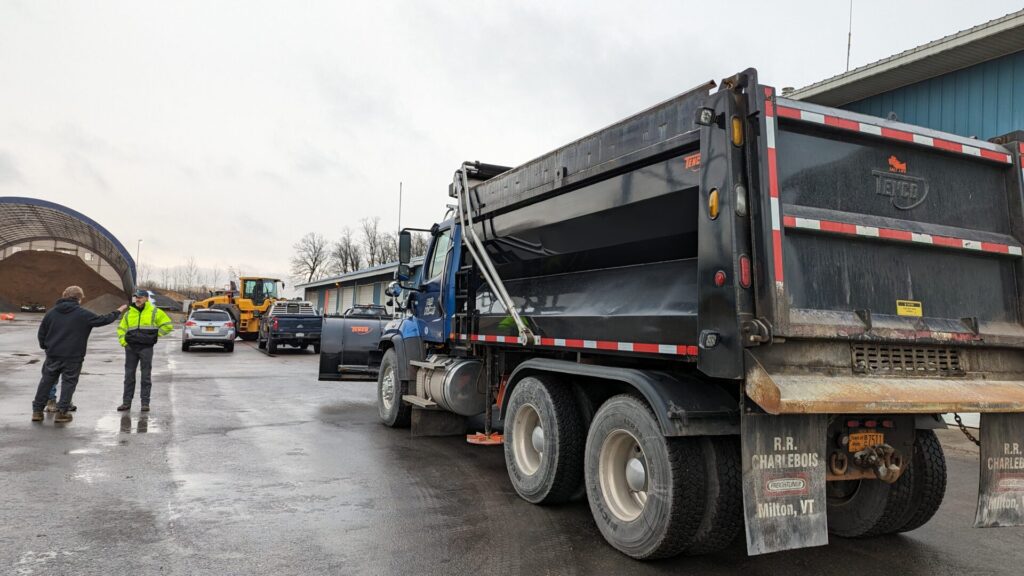Guest Author Mikala L’Hote, Graduate Research Assistant with the Adirondack Watershed Institute, shares answers to some of the commonly asked questions about road salt:
What is road salt?
Also known as “rock salt,” the most common variation of road salt used is sodium chloride (NaCl), which is essentially common table salt. NaCl is useful at temperatures above -9.5°C (15 °F) and, because of its low-cost and high availability, has continued to be the most commonly applied chemical for road de-icing. Over time, other substitutes have been engineered and may be used in conjunction with NaCl, including calcium chloride (CaCl2), magnesium chloride (MgCl2), and potassium chloride (KCI). Although many newer alternatives have proven to be effective in certain conditions and lower temperatures, associated downfalls exist, like higher cost and understudied environmental and public health impacts.
How does road salt work?
Road salt works by lowering the freezing point of water, making it more difficult for ice to form at colder temperatures. When dissolved, sodium chloride ions break up the crystalline structures formed by water molecules in their solid state, making it harder for them to form a strong structure (aka freeze). Road salts in their solid form, or liquid solutions called “brine”, can be used before a storm to prevent ice from forming.
The following video provides a good explanation of how road salt works:
Why should I care about the fate of road salt in the environment?
Increased concentrations of road salt can have drastic negative impacts on the environment. The consequences of increased road salt usage span across freshwater systems in the form of lake, stream, and groundwater contamination. Road salting can contribute 60-90% of elevated salt concentrations in freshwaters in regions where it is employed as a roadway de-icing tool. Salinization of these systems can lead to ecological, environmental, and public health implications. Ecologically, elevated chloride and sodium levels have been shown to decrease the survival of numerous aquatic and terrestrial species, alter lake chemistry and stratification, and alter ionic soil composition. Components of road salt are highly corrosive and thus have the potential to degrade vehicles and roadside infrastructure. This corrosivity, when paired with increasing groundwater salinization, can also lead to metal leaching in older plumbing infrastructure, impacting the quality of drinking water and posing a threat to public health.
Do any guidelines exist that address the components of road salt?
The U.S. Environmental Protection Agency (EPA) has instituted both chronic or “long term” (230 mg/L ) and acute or “short term” (860 mg/L) exposure levels for dissolved chloride in freshwaters(U.S. EPA. 1998). Additionally, for drinking water, the U.S. EPA recommends that drinking water sodium concentrations not exceed 30 to 60 mg/L to avoid adverse effects on taste, while the recommended guideline is decreased to 20 mg/L for individuals on a very low sodium diet (500 mg/day) (U.S. EPA, 2003). Some argue that the U.S. standards, specifically pertaining to chloride, are not strict enough. Recent studies have indicated that the effectiveness of these exposure levels is understudied and may not be enough to adequately protect aquatic and terrestrial organisms, let alone the broader effects of surface and groundwater salinization.
Recently, groups and organizations have addressed the questions of chloride thresholds. In Canada, lower chloride thresholds exist per requirements of the Canadian Environmental Quality Guidelines, which have set chronic toxicity at 120 mg/L and acute at 640 mg/L. In recognition of the environmental effects posed by de-icing salt in the environment, Canada has recently begun re-evaluating these guidelines and is considering categorizing road salt as a “toxic” substance.
The NY DEC’s Consolidated Assessment and Listing Methodology suggests chloride values of 42.7 mg/L for flowing waters and 30.9 mg/L for ponded waters, while the Adirondack Road Salt Reduction Taskforce Report, using results seen in recent scientific literature, suggests a value as low as 10 mg/L of chloride in surface waters to protect aquatic life.
Is anything being done to decrease road salt use?
Although every solution or alternative to winter road de-icing has flaws, adopting Best Management Practices (BMP’s) across cold regions can contribute to protecting our freshwater resources. By rethinking existing management practices and introducing new concepts, BMP’s exist as tools that aim to address the issue of road salt usage through a more environmentally friendly and cost-effective practices. Many BMP’s aim to address salt application rates and prevent overuse; these include strategically using alternative salts that may be more effective at different temperatures, implementing anti-icing practices (like brining) that act to preemptively prevent the bonding of snow and ice to pavement, or identifying high risk zones that may need further consideration.
Other examples include the employment of Road Weather Information Systems (RWIS) to provide plow drivers with real-time weather conditions that can inform both application type and rate, and truck retrofitting with components like salt regulators or new live edge plows. These are only a few examples of BMP’s that are being implemented to address the issue of road salt, ideally making the process more environmentally friendly and cost-effective in the long term. A management decision aimed at the reduction of salt application would immediately address the root of this problem, but come hand in hand with other caveats, like public safety. Overall, BMP’s have proven to be effective in reducing the impacts of road salt on receiving water bodies while accommodating for external economic and social considerations.
Stay tuned for upcoming blog posts in the Road Salt Series for a deep dive into case studies that address various scales, salinization drivers, and applied BMP’s!
About the Paul Smith’s College Adirondack Watershed Institute 
The mission of the Paul Smith’s College Adirondack Watershed Institute is to protect clean water, conserve habitat and support the health and well-being of people in the Adirondacks through scientific inquiry, stewardship and real-world experiences for students. To learn more, visit adkwatershed.org.
About the Author
Mikala L’Hote is a current master’s student at Paul Smith’s College studying Natural Resource Conservation, where she serves as a Graduate Research Assistant with the Adirondack Watershed Institute. Her graduate research specifically addresses landscape-level drivers and impacts of road salt use on lakes within the Lake Champlain Basin, aiming to provide both the general public and key stakeholders with the information needed to understand and address road salt application across the basin.
Sources:
Betts, A., Gharabaghi, B., McBean, E., Levison, J., & Parker, B. (2015). Salt vulnerability assessment methodology for municipal supply wells. Journal of Hydrology, 531, 523–533. https://doi.org/10.1016/j.jhydrol.2015.11.004
Dugan, H. A., Bartlett, S. L., Burke, S. M., Doubek, J. P., Krivak-Tetley, F. E., Skaff, N. K., Summers, J. C., Farrell, K. J., Mccullough, I. M., Morales-Williams, A. M., Roberts, D. C., Ouyang, Z., Scordo, F., Hanson, P. C., & Weathers, K. C. (2017). Salting our freshwater lakes. PNAS, 114(17). https://doi.org/10.6073/pasta/455d73d4cb43514e503826211eba4e99
Canadian Council of Ministers of the Environment. 2011. Canadian water quality guidelines for the protection of aquatic life: Chloride. In Canadian environmental quality guidelines, 1999, Canadian Council of Ministers of the Environment, Winnipeg. https://sustainabletechnologies.ca/app/uploads/2014/05/CWQG_chlorides.pdf
Hintz, W. D., & Relyea, R. A. (2017). A salty landscape of fear: responses of fish and zooplankton to freshwater salinization and predatory stress. Oecologia, 185(1), 147–156. https://doi.org/10.1007/s00442-017-3925-1
Kelly, V., Findlay, S., Schlesinger, W., Menking, K., & Chatrchyan, A. (2010). Road Salt, Moving Toward the Solution. https://doi.org/10.13140/RG.2.1.2230.9920
Kelting, D. L., & Laxson, C. L. (2010). Review of Effects and Costs of Road De-icing with Recommendations for Winter Road Management in the Adirondack Park. https://www.adkaction.org/wpcontent/uploads/2019/02/Review-of-Effects-2010.pdf
Kelting, D. L., Laxson, C. L., & Yerger, E. C. (2012). Regional analysis of the effect of paved roads on sodium and chloride in lakes. Water Research, 46(8), 2749–2758. https://doi.org/10.1016/J.WATRES.2012.02.032
New York State Department of Environmental Conservation (2021). Consolidated Assessment and Listing Methodology. https://www.dec.ny.gov/docs/water_pdf/calmmay2021.pdf
New York State Department of Environmental Conservation, New York State Department of Transportation. (2023). Adirondack Road Salt Reduction Task Force Assessment and Recommendations. https://www.dec.ny.gov/docs/administration_pdf/adirondackroadsaltreport.pdf
Novotny, E. V., & Stefan, H. G. (2012). Road Salt Impact on Lake Stratification and Water Quality. Journal of Hydraulic Engineering, 138(12), 1069–1080. https://doi.org/10.1061/(asce)hy.1943-7900.0000590
Pieper, K. J., Tang, M., Jones, C. N., Weiss, S., Greene, A., Mohsin, H., Parks, J., & Edwards, M. A. (2018). Impact of Road Salt on Drinking Water Quality and Infrastructure Corrosion in Private Wells. Environmental Science and Technology, 52(24), 14078–14087. https://doi.org/10.1021/acs.est.8b04709
Tiwari, A., & Rachlin, J. W. (2018). A Review of Road Salt Ecological Impacts. Northeastern Naturalist, 25(1), 123–142. https://doi.org/10.1656/045.025.0110
United States Environmental Protection Agency. (1988). Ambient Water Quality for Chloride. https://www.epa.gov/sites/default/files/2018-08/documents/chloride-aquatic-life-criteria-1988.pdf
United States Environmental Protection Agency. (2003). Drinking Water Advisory: Consumer Acceptability Advice and Health Effects Analysis on Sodium. https://www.epa.gov/sites/default/files/2014-09/documents/support_cc1_sodium_dwreport.pdf
Wiltse, B., Yerger, E. C., & Laxson, C. L. (2020). A reduction in spring mixing due to road salt runoff entering Mirror Lake (Lake Placid, NY). Lake and Reservoir Management, 36(2), 109–121. https://doi.org/10.1080/10402381.2019.1675826
Video:
AumSum Time. (2018). Why is salt added to icy roads? YouTube. Retrieved from https://youtu.be/6V_AVe3zWu8.






